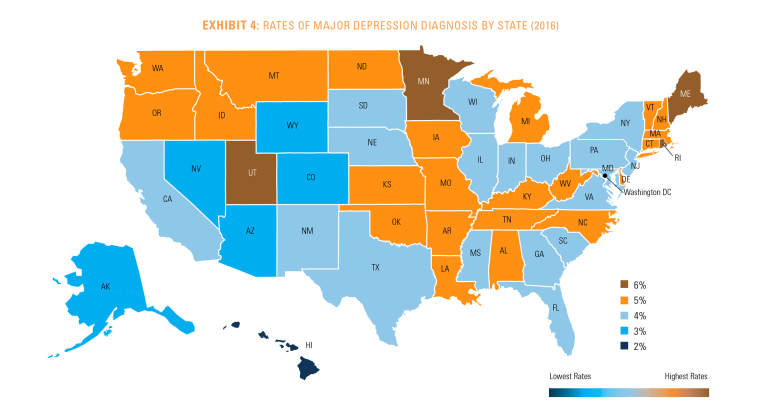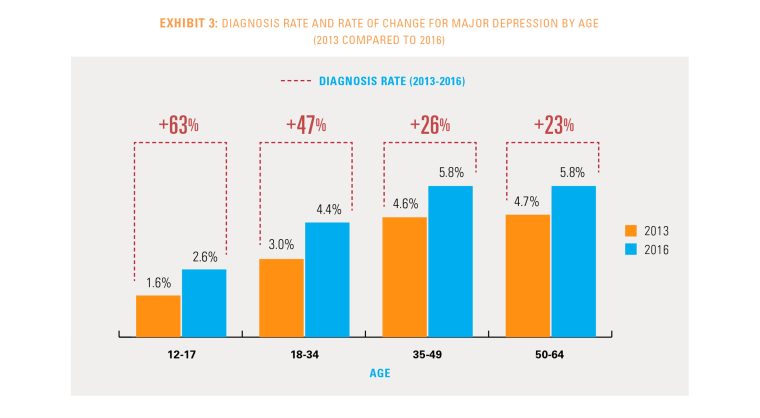Major depression is on the rise among Americans from all age groups, but is rising fastest among teens and young adults, new health insurance data shows.
Depression rates also vary a lot state by state, with Rhode Island having the highest rate of depression at 6.4 percent. Hawaii has the lowest rate — 2.1 percent.
The findings cover people with commercial health insurance — Blue Cross and Blue Shield — so they’re not fully representative. But most people in the U.S. are covered by a commercial health plan.

The findings are almost certainly an underestimate, as well. The Blue Cross Blue Shield data comes from 41 million health records and counts people who got a diagnosis of major depression. Many people who report symptoms of depression say they have not been diagnosed or sought treatment for it.
What’s behind the increase?
“Many people are worried about how busy they are,” said Dr. Laurel Williams, chief of psychiatry at Texas Children’s Hospital.
“There’s a lack of community. There’s the amount of time that we spend in front of screens and not in front of other people. If you don’t have a community to reach out to, then your hopelessness doesn’t have any place to go.”
Kids and young adults, especially, feel rushed and pressured, Williams said.
While social media can connect people who might otherwise feel isolated, it can also help pile on the pressure, she said.
“I wouldn’t say that social media is responsible for a rise in depression — more the being rushed and lack of connections that we have in the structure of how we live lives now,” she added.
But Dr. Karyn Horowitz of Bradley Hospital in Rhode Island thinks social media may be a big factor.
“For some kids, video game use can become an addiction leading to social isolation, poor school performance, and impaired sleep,” she said.
“It is possible that the increased rates of depression in adolescents is related to a combination of increased electronics use and sleep disruptions in already vulnerable individuals,” she added.
For the report, Blue Cross and Blue Shield looked at medical health insurance claims from 41 million insurance holders.

They found 4.4 percent of them had a diagnosis of major depression in 2016.
"Diagnoses of major depression have risen dramatically by 33 percent since 2013," the report reads.
According to the report, 2.6 percent of youths aged 12 to17 were diagnosed with major depression in 2016, a 63 percent increase from 1.6 percent in 2013.
Among young adults aged 18 to 34, 4.4 percent had major depression in 2016, compared to 3 percent in 2013. That’s a 47 percent increase.
The highest percentage of major depression diagnoses were among people aged 35 to 49. The survey found 5.8 percent of 35-to 49-year-olds had major depression in 2016, compared to 4.6 percent three years before.
Most people had some other condition along with depression and 29 percent had four or more additional health problems such as diabetes or heart disease, the report found.
Medical problems can lead to depression, according to the Centers for Disease Control and Prevention.
Depression “may be caused by a combination of genetic, biological, environmental, and psychological factors,” the CDC says.
Risk factors include:
- Experiencing traumatic or stressful events, such as physical or sexual abuse, the death of a loved one, or financial problems
- Going through a major life change‚ even if it was planned
- Having a medical problem, such as cancer, stroke, or chronic pain
- Taking certain medications
- Using alcohol or drugs
- Having blood relatives who have had depression
Perhaps most troubling is the high rate of children and young adults who have depression, the report said. Many years of risk lie ahead if they do not get treatment, which can include medication, therapy or both.
The CDC says one in five children ages 3 through 17 — about 15 million — have a diagnosable mental, emotional or behavioral disorder in a given year. But only 20 percent of them get diagnosed or receive care.
Children with depression often seem irritable rather than sad or anxious, the National Institute of Mental Health says. That can make symptoms easy to miss, as can their busy lives.
“A lot of parents will say to me, ‘Well, she seemed fine to me and she was going to school,’” Williams said.
“A lot of people go through the motions.”


